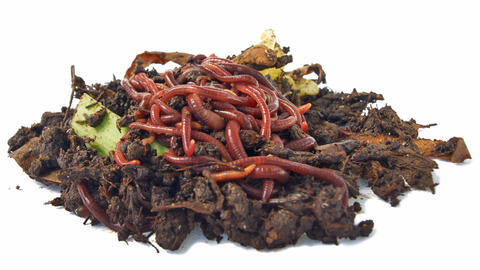Creating Your Own Vermicompost / Worm compost
Manure worms feed on organic waste that they turn into vermicompost, a valuable organic fertilizer. You can simply leave the creatures to get on with their work in a vermicomposter, known as a worm composting bin - even on the balcony!

Manure worms turn organic waste into worm humus
A worm composting bin is a worthwhile investment for any gardener - whether you have a garden or not: You can use it to dispose of household waste, and the hard-working manure worms turn it into valuable vermicompost. There is hardly an animal family on this planet so valued as that of the earthworm. And their work is extremely important for hobby gardeners. They push tirelessly through the soil with their tubular system and thereby improve both the ventilation and the water drainage. They also collect dead plant remains from the surface, digest them and enrich the surface soil with nutrient-rich worm humus.
There are around 40 species of earthworm, divided into three groups: The anecic worms such as the Lumbricus terrestris, dig up to 8.2 feet deep burrows. The endogeic species do not build burrows, but dig more or less parallel to the surface through the garden soil or farmland. Depending on the species they are green, blue, gray or colorless. Only manure worms can be used in a worm composting bin. In nature, they live as epigeic species in the surface layer of the soil and therefore generally in a purely humus environment. Manure worms are relatively small, reproduce very quickly and are easy prey for birds and moles.

Manure worms, the most important representative of which has the zoological name Eisenia fetida, are extremely interesting for making your own vermicompost. But you don’t need to go looking for them in the forest; you can buy the worms or their cocoons including breeding accessories in trade shops. You can simply release the manure worms on the compost pile in the garden to accelerate its decomposition. However, the worms can also live in a special worm composting bin on the balcony, or even in the house - so even gardeners without a garden can create nutrient-rich vermicompost from kitchen and balcony waste for their potted plants.
Decomposition is fastest in low vermicomposters with as large a surface area as possible - up to 20,000 manure worms are simultaneously active in 10.76 square feet! Important: Only ever fill a thin layer of waste and distribute this across the entire surface area, as the transformation must take place “cold”. Excessive organic material starts to rot easily and the high temperatures this causes lead to certain death for manure worms.

Worm composting bins generally consist of flat, stackable boxes with perforated base plates. When the bottom floor is full, another box is simply placed on top. After it reaches a fill heigth of 5.91 to 7.87 inches, almost all of the manure worms have crept through the sieve base into the upper floor with the fresh food - at this point you take out the first box with the finished worm humus and empty it. Larger vermicomposters for the garden generally work according to the two chamber principle. They have a vertical perforated separating wall through which the manure worms can migrate from the finished worm humus into the chamber with fresh waste.

Manure worms such as Eisenia fetida produce nutrient-rich organic fertilizer from organic waste. The decomposition to worm humus occurs around four times more quickly in ideal conditions in a special worm composting bin than in standard composting. A temperature between 59 and 77 degrees Fahrenheit, the most even moisture possible, and good ventilation are important. Each manure worm eats half its own body weight in organic material every day, whereby the volume of waste is reduced to about 15 percent. The reproduction rate of the worms is also extremely high - the population can increase one thousand-fold within a year under ideal conditions.

Unlike a normal compost pile, the material in the vermicomposter cannot be turned and the process is completely odorless. You can feed the manure worms with all plant (garden) waste, including flour, noodles, black and white printed paper, coffee filters, eggshells and animal droppings - although the latter should be pre-composted. Meat and waste with a heavy fat or acid content such as pickled cabbage or salad dressings with vinegar are not ideal. Set up your worm composting bin in a shady location so that it does not heat up too much in the summer and overwinter it out of the frost, for example in a basement.



